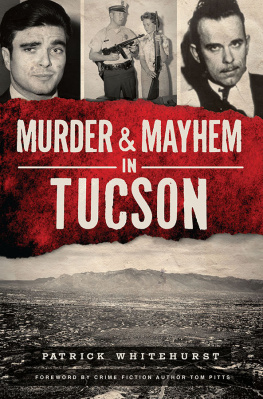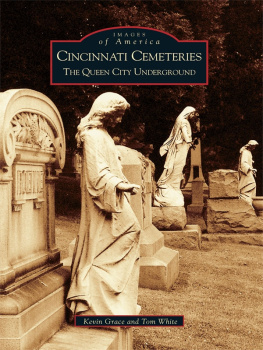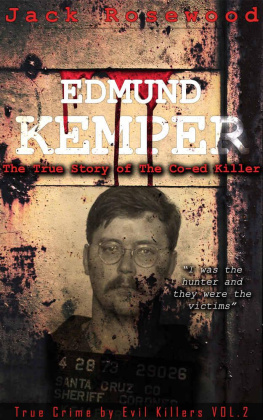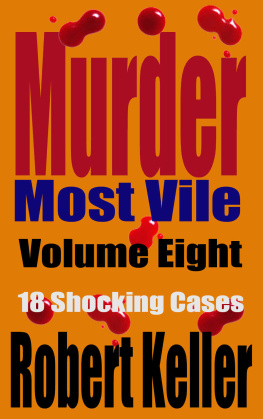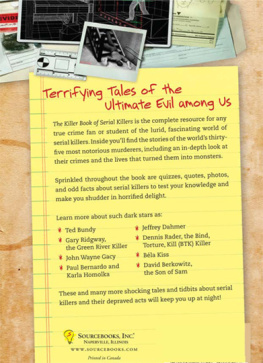

Published by The History Press
Charleston, SC
www.historypress.com
Copyright 2021 by Roy Heizer
All rights reserved
Front cover, top: courtesy of WCPO-9; bottom: courtesy of WCPO-9.
First published 2021
E-Book edition 2021
ISBN 978.1.43967.292.1
Library of Congress Control Number: 2021937209
Print Edition ISBN 978.1.46714.807.8
Notice: The information in this book is true and complete to the best of our knowledge. It is offered without guarantee on the part of the author or The History Press. The author and The History Press disclaim all liability in connection with the use of this book.
All rights reserved. No part of this book may be reproduced or transmitted in any form whatsoever without prior written permission from the publisher except in the case of brief quotations embodied in critical articles and reviews.
CONTENTS
This book is dedicated to all of the men and women who were victims of these sinister stories.
May they all rest in peace.
ACKNOWLEDGEMENTS
The author, Roy Heizer, would like to thank and acknowledge The History Press for the opportunity to tell the stories of Cincinnatis morbid and sinister history.
I would also like to thank my wife, Nancy, for all her help and support.
A special thank-you to my friend and fellow historian Tim Kraus. Without his help, the Coleman Avery story would not have been possible. I thank him also for permission to photograph items related to the story.
A profound thank-you to the Cincinnati Enquirer. Without its archives, this book would not have been possible. Cincinnatis longest-running newspaper has proved invaluable to my research, and it is greatly appreciated.
I would also like to thank the Ohio History Connection and the University of Cincinnati Librarys online archives. Both have been extremely helpful for the research that went into this book.
I also thank all the business, church, synagogue, and community websites around Cincinnati for providing a wealth of information. You know your history better than anyone, and I thank you for sharing it with us all.
Appreciation goes to Dan Smith with Haunted Cincinnati Ghost Tour for spinning weird and wretched tales from the paranormal realm. I learned so much on your tour through Over-the-Rhine.
Last but never least, I would like to thank the citizens of Cincinnati, past and present. Together, they have created a rich and diverse history for all of us to study and understand. It is your stories I have tried faithfully to tell here. From the criminals who operated in the shadows, to the heroes who lead us through our bleakest hours, thank you one and all for what you have contributed to our amazing city!
INTRODUCTION
Cincinnati has always been a city of great diversity and extremes. In its 233 years, Cincinnati has seen the best and the worst of humanity and nature. Our local scientists have achieved noble goals, saving countless lives, while an influenza outbreak killed hundreds of citizens. German Americans created a legendary beer-brewing culture, while one of their own murdered them one after the other. We have built skyscrapers that were among the tallest in the world. At the same time, angry townsfolk destroyed an enormous courthouse during a time of unrest. Many Cincinnatians have become famous for their tenacity and accomplishments; others have become famous for their untimely deaths. A sunny day can turn into a fierce destructive storm in minutes. There are stories of shocking crimes that plumb the depths of human depravity, and tales of awe that send shock and blood across the headlines of yesteryear. The scales of justice oscillate, sometimes slowly, sometimes quickly, in The City of Seven Hills.
Isaac Newton once said, For every action, there is an equal and opposite reaction. That observation has never been more fitting than for Cincinnati.
Cincinnati Murder & Mayhem is a collection of stories from the sinister side of Cincinnati. The Queen City, as locals call it, has always been a place of wonder and progress, but it has its darker side as well. These tales from the morose underside of Cincinnati create a backdrop of city lifeand deathin the nineteenth and twentieth centuries. There are two sides to Cincinnati, so come explore mystifying stories of true crime, natural disasters, civil unrest, and more, all from the morbid side of greater Cincinnatis unrepentant history.
THE EASTER SUNDAY SLAUGHTER
Hamilton, Ohio, is a small town of sixty-three thousand residents about twenty miles north of Cincinnati proper. Its usually a quiet, safe, and friendly place in which to live. Large trees line neat streets, single-family homes, and the downtown features historic buildings, open parks, and the remnants of the Miami and Erie Canal. The local Christmas parade, trick or treating and Fourth of July celebrations bring the community together, while Thanksgiving and Easter bring families together. It has the feel of a small midwestern town, with the amenities of a larger city close at hand. To most folks, Hamilton must seem more Mayberry than Manhattan. It would be easy to forget the harshness of reality in Hamiltons bucolic nature, but sometimes, that perfect picture is shattered by a single headline.
On Easter Sunday, March 30, 1975, James Urban Ruppert murdered eleven family members in his mothers house at 635 Minor Avenue in Hamilton. The incident is now known as the Easter Sunday Slaughter.
Rupperts early life was, according to court testimony, unstable. He was born on April 12, 1934. His mother, Charity, would tell him that she would have rather had a daughter. His father, Leonard, had a violent temper. He didnt care much about James or his brother Leonard Junior. As a child, James suffered from asthma and was not able to participate in a lot of activities due to the condition. James frequently told people that his mother hated him; he claimed that his mother beat him and encouraged Leonard to participate in the beatings.
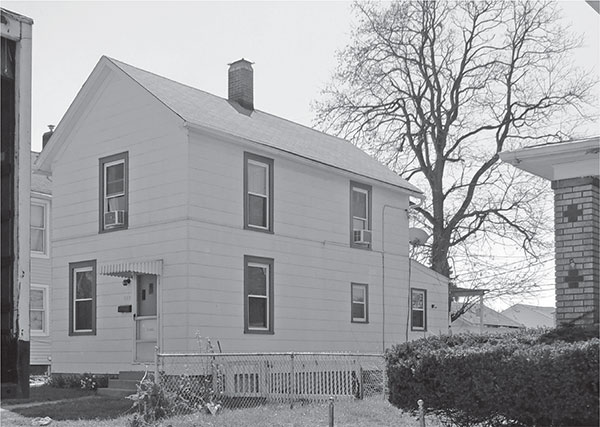
The Ruppert family home. Photo in public domain.
Fortunately, or unfortunately for James, Leonard Sr. died in 1947, when James was twelve. Leonard Jr. became the father figure in the house and made life difficult for young James. Things got so bad that when he was sixteen, James tried to commit suicide by hanging himself with a sheet.
As an adult, James Ruppert was described as a quiet and helpful yet unremarkable man. The young man had no police record. James was jealous of his older brothers good job and family life. After two years, he flunked out of college while his brother earned a degree in electrical engineering and did well in athletics. Leonard Jr. also married Jamess ex-girlfriend, and the couple had eight children. Leonard had a good job with General Electric, while James was unemployed at the age of forty-one. James was a designer of jet engines and mechanical apparatuses by trade, but on becoming unemployed he moved back in with his sixty-five-year-old mother, Charity. The formerly semi-successful James had hit on hard times. He was described by those who knew him as a loner and an assiduous reader. His mother threatened to evict him because she was fed up with him not holding a job and his constant drinking. James also owed his mother and brother money. As pressure mounted on James, he withdrew into a world of solitude and alcohol.
Next page





